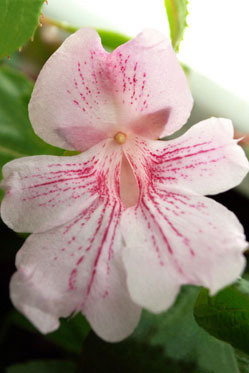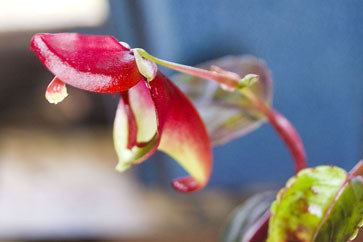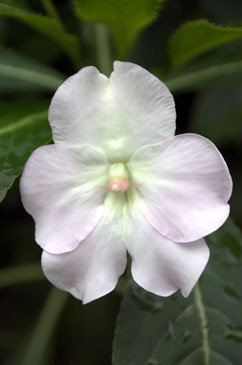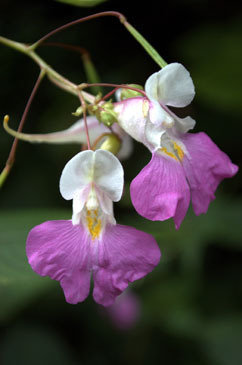





Hybrid impatiens plants might be the best annuals out there for covering shady ground fast. Hey, they aren't called impatient for nothing! And few flowers bloom as neatly and profusely as they do in shade. But all that consistency can be a bit boring. I must admit to a sneaking preference for the species types, which tend to be more leggy, awkward, and obstinate.
 Although some of them flower furiously as well--and fling seed about in a downright profligate way--others refuse to bloom at all except at certain times of year. Both I. grandis and I. hians, for example, will only flower when the days are short. That can make them tricky for those of us who live where winter is actually winter, with below freezing temperatures.
Although some of them flower furiously as well--and fling seed about in a downright profligate way--others refuse to bloom at all except at certain times of year. Both I. grandis and I. hians, for example, will only flower when the days are short. That can make them tricky for those of us who live where winter is actually winter, with below freezing temperatures.
Those impatiens have flowered for me--under grow-lights set for 12-hour days--and I have the photos to prove it! But even then they can be grudging. And older plants don't seem to bud as well as young ones.
On the upside, because the two impatiens have waxier leaves than hybrids, the low humidity indoors during winter doesn't seem to bother them much. So the plants are easy to keep alive, just not as easy to force into bloom. Impatiens sodenii too has thicker foliage and, since it is called poor man's rhododendron, must bloom well in milder climates. But its bulky build isn't well suited to pots, so it only blooms in fits and starts for me, both indoors and out. I probably should set it in the ground instead and see if it will self-sow. 
I. arguta, which has more tender foliage, did survive under the grow-lights too--but barely! It perked up quickly, however, once moved out of the house this spring. As it is obviously one of those plants which prefers the outdoors, I would advise those of you in the zones from 7 up to leave it there.
 Impatiens balfourii and I. glandulifera will both flower well outdoors in Zone 5, and obligingly seed themselves down afterwards too. They will do that during normal years, I mean. This year, when winter was too mild and temperatures heated up too early, the emerging seedlings must have gotten hit by the inevitable late freeze. They are noticeably absent this summer, and I miss them, even though I suspect some of you in warmer climates might find them invasive.
Impatiens balfourii and I. glandulifera will both flower well outdoors in Zone 5, and obligingly seed themselves down afterwards too. They will do that during normal years, I mean. This year, when winter was too mild and temperatures heated up too early, the emerging seedlings must have gotten hit by the inevitable late freeze. They are noticeably absent this summer, and I miss them, even though I suspect some of you in warmer climates might find them invasive.
 Speaking of invasive, jewelweed (Impatiens capensis or I. pallida) will survive anything--probably because it produces so much seed. It grows wild here in Pennsylvania and, if rubbed on the affected skin soon enough, is considered the sovereign remedy for poison ivy. Children like the way water rolls around like mercury on its leaves, and how explosively its seed pods pop. But I wouldn't advise planting it on purpose!
Speaking of invasive, jewelweed (Impatiens capensis or I. pallida) will survive anything--probably because it produces so much seed. It grows wild here in Pennsylvania and, if rubbed on the affected skin soon enough, is considered the sovereign remedy for poison ivy. Children like the way water rolls around like mercury on its leaves, and how explosively its seed pods pop. But I wouldn't advise planting it on purpose!
I still adore my more unusual impatiens, despite their eccentricities! After all, the fewer flowers I get from a plant, the more I tend to treasure those few. And I'm still hoping to find some other exotic types, such as I. tinctoria and the true blue I. namchabarwensis. (Hint, hint.) I. tinctoria probably wouldn't be practical for me either, due to its massive foliage, but it does have gorgeous blooms. And when have we gardeners ever been known to be practical?
Copyright © www.100flowers.win Botanic Garden All Rights Reserved